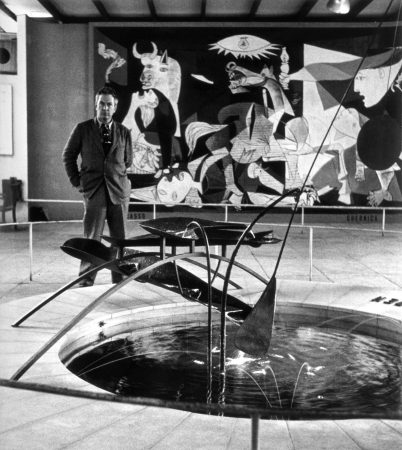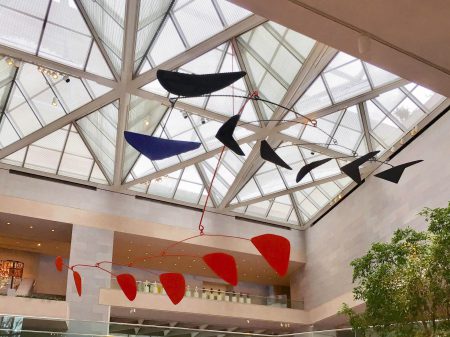Archive
See highlights from 1963–1976 on the timeline Monumental Works
The Calders move into the new house at Saché.
Lipman 1976, 338
Louisa Calder, Le Carroi house, Saché, 1976
Photograph by Pedro Guerrero © Pedro GuerreroLouisa Calder, Le Carroi house, Saché, 1976
Photograph by Pedro GuerreroIn France, Calder makes The Stevens Mobile to commemorate Stevens’ one-hundredth anniversary.
CF, project fileThe Calders return to the United States.
CF, passportThe Calders dine at the Cosmopolitan Club in New York with daughter Mary and Calder’s sister, Peggy.
CF, MCR datebookThe Calders attend the reception and private viewing of the current exhibitions at the Museum of Modern Art, New York, including “A Salute to Alexander Calder.”
CF, MCR datebookThe Calders have lunch at Del Pezzo.
CF, MCR datebookThe Calders have dinner with daughter Mary and Elodie and Nick Osborn. Soon after, they depart for France.
CF, MCR datebookCalder is commissioned by Klaus Perls, Robert Graham, and Morton Rosenfeld to design a sidewalk strip on Madison Avenue between Seventy-eighth and Seventy-ninth Streets.
CF, project fileCalder’s black-and-white Sidewalk is installed.
CF, project fileThe Calders arrive in New York.
CF, passportPerls Galleries, New York, exhibits “Alexander Calder: Recent Gouaches–Early Mobiles.”
CF, exhibition fileCalder and Louisa return to New York following a brief stay in Roxbury.
CF, MCR datebookThe Calders have dinner in New York with the Osborns.
CF, MCR datebookThe Calders depart for France.
CF, MCR datebook1971
Calder designs sets and costumes for the ballet Amériques, choreographed by Norbert Schmuki, scored by Edgard Varèse, and performed by the Ballet-Théâtre Contemporain in Amiens, France.
CF, object fileGalerie Maeght, Paris, exhibits “Calder: Stabiles and Animobiles.” The catalogue text includes “Calder la liberté” by Carlos Franqui, with cover and illustrations by Calder.
CF, exhibition fileThe American Academy of Arts and Letters and the National Institute of Arts and Letters awards Calder the Gold Medal for Sculpture. Calder’s work is shown in the Academy’s group exhibition from 27 May–20 June.
Lipman 1976, 338; CF, awards fileThe Calders arrive in New York.
CF, passportThe Calders arrive in New York.
CF, passportPerls Galleries, New York, exhibits “Calder: Animobiles–Recent Gouaches.” Klaus Perls writes the catalogue text.
CF, exhibition fileThe Calders return to France.
CF, calendar1972
The Calders arrive in New York.
CF, MCR datebookCalder and Louisa attend events surrounding the opening of “Calder’s Circus,” curated by Jean Lipman, at the Whitney museum of American Art, New York.
CR, MCR datebookThe Calders have dinner in New York with daughter Mary.
CF, MCR datebookThe Calders depart for France.
CF, MCR datebookThe Calders sponsor an ad in the New York Times calling for Richard Nixon’s impeachment: Upon the Impeachment of Richard Nixon, for high crimes and misdemeanors, the Constitution of the United States, provides that he, among others shall be removed from office . . .
for conviction of, treason, bribery, or other high crimes and misdemeanors.
The Museum of Fine Arts, Houston, presents “A Child’s Summer with Calder and Miró.”
CF, exhibition fileSala Pelaires, Palma de Mallorca, presents “Calder.” Miró writes a poem for the catalogue.
CF, exhibition fileCalder arrives in New York, four days after Louisa.
CF, MCR datebookPerls Galleries, New York, exhibits “Alexander Calder: Oil Paintings.”
CF, exhibition fileThomas Messer takes the Calders, Serts, and Rowers out to dinner prior to the opening of “Joan Miró: Magnetic Fields” at the Solomon R. Guggenheim Museum, New York.
CF, MCR datebookCalder travels to Roxbury with Klaus Perls and Daniel Lelong.
CF, MCR datebookCalder and Louisa have dinner in New York at the home of daughter Mary.
CF, MCR datebookThe Calders depart for France.
CF, MCR datebookFuji Television Gallery Co., Ltd., Tokyo, presents “Calder / Miró.”
CF, exhibition fileGalerie Beyeler, Basel, presents “Miró / Calder.”
CF, exhibition file1973
Calder gives the Mercury Fountain to the Fundació Joan Miró, Barcelona. The museum was designed by Sert. The fountain is installed in June 1975.
CF, project fileCalder donates a lithograph, Balloons, to the Nicaragua Earthquake Relief, organized to aid the victims of the earthquake in Managua.
CF, project fileGalerie Maeght, Paris, exhibits “Calder: Recent Mobiles.” The catalogue text includes “Retour au mobile” by Maurice Besset and “Calder ou le poids de l’air” by André Balthazar, with cover and illustrations by Calder.
CF, exhibition fileGalerie Maeght, Zurich, exhibits “Alexander Calder: Retrospektive.” C. Giedion-Welcker writes the introduction for the catalogue.
CF, exhibition fileThe Board of Trustees of the National Gallery of Art commissions Calder to make a monumental sculpture for its new building. The mobile, designed specifically for the central court of the National Gallery’s East Building, is completed and installed after Calder’s death in
1976.
The Calders arrive in New York and have dinner with Klaus Perls.
CF, MCR datebookCalder and Louisa travel to Roxbury.
CF, MCR datebookThe Calders spend time in Roxbury with Arthur Miller and Inge Morath, Robert and Elodie Osborn, and Klaus Perls.
CF, MCR datebookThe Calders return to New York.
CF, MCR datebookCalder and Louisa have dinner in New York at the home of daughter Mary.
CF, MCR datebookPerls Galleries, New York, exhibits “Calder at 75–Works in Progress.”
CF, exhibition fileThe Calders have dinner in New York at the home of daughter Mary.
CF, MCR datebookThe Calders travel to Roxbury.
CF, MCR datebookCalder attends the dedication ceremony for the monumental stabile Stegosaurus at the Alfred E. Burr Memorial Mall in Hartford. Following the event, he receives an honorary Doctor of Fine Arts from the University of Hartford.
CF, project fileCalder visits the new Dallas-Fort Worth Airport to view the DC-8-62 jet Flying Colors, his commission from Braniff International Airways. He hand paints Sunburst and Beastie on the port-side engine cowlings.
New York Post, 31 October; Lipman 1976, 339Flying Colors makes its inaugural flight from Dallas Love Field to Los Angeles, Chicago, and New York City—where the Calders disembark—before continuing to Washington D.C., Miami, and Latin America.
Friends on board with the Calders include Ruth and Leonard Horwich, Jean Lipman, Dorothy Miller, Nancy Mulnix, Elodie and Robert Osborn, Andi Schlitz, and Leslie and Rufus Stillman; family members include the Calders’ daughter Mary, who is joined by husband Howard and sons Holton and Alexander, and Calder’s sister, Peggy.
The Calders depart for France.
CF, MCR datebook1974
The film Gouaches de Calder, directed by Carlos Vilardebó, is released.
CF, project filePrompted by Calder’s project with Braniff International Airways to paint a DC-8 jet, French auctioneer and racecar driver Hervé Poulain commissions Calder to design the first-ever BMW Art Car.
CF, object file
Calder accepts the Commandeur de la Légion d’Honneur of France; Michel Debré, the former French premier, presents the award.
CF, awards fileCalder and Louisa attend a dinner organized by Aimé Maeght at Mouln de la Galette celebrating Miró’s exhibition at the Grand Palais, Paris.
CF, invitation; CF, Descargues to Calder, 7 May; CF, photography fileCalder is named Citoyen d’Honneur de la Commune by the Mayor of Saché.
CF, awards fileCalder donates the monumental sculpture Totem-Saché, installed in the main square of the town of Saché.
Lipman 1976, 339The Calders return to New York.
CF, MCR datebookPerls Galleries, New York, exhibits “Alexander Calder: Crags and Critters of 1974.”
CF, exhibition file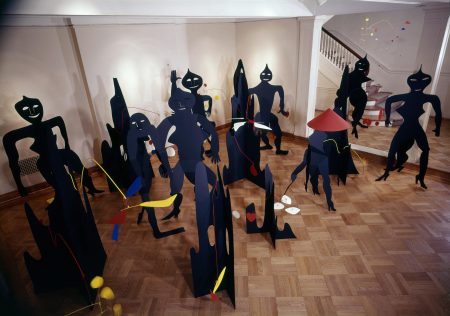
The festival “Alexander Calder Day” in Chicago includes a circus parade with the Schlitz forty-horse hitch and the dedications of the motorized Universe at the Sears Tower and the monumental stabile Flamingo at the Federal Center Plaza. Calder is given a key to the city by Mayor Richard M. Daley.
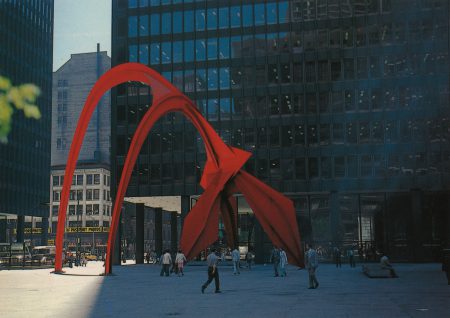
Calder receives the Grand Prix National des Arts et des Lettres from the French Minister of Culture Michel Guy.
CF, awards file1975
Hooks-Epstein Galleries, Houston, presents “Calder and Miró: Works on Paper 1957–1974.”
CF, exhibition file“Calder: Crags and Critters” is presented at Galerie Maeght, Paris. The catalogue text includes the essay “Un tournant chez Calder” by Mario Pedrosa; cover and illustrations by Calder. The exhibition travels to Galerie Maeght, Zurich.
CF, exhibition fileThe Calders visit Israel to discuss a monumental sculpture project with the Mayor of Jerusalem, Teddy Kollek. Jerusalem Stabile I is completed in 1976 and Louisa attends the dedication ceremony in 1977.
New York Times, 12 May; CF, project fileAfter construction, testing, and maintenance, the Calder BMW Art Car is painted.
CF, object fileHaus der Kunst, Munich, exhibits “Calder,” a retrospective. The catalogue includes the essay “Entstehung des Mobile” by Maurice Besset.
CF, exhibition fileThe Calders, Marcel Breuer, and others who worked on the UNESCO building in Paris protest UNESCO’s expulsion of Israel in a New York Times ad: We artists who are citizens of the world urge the General Conference to reverse itself and end all sanctions against Israel, and let
the building we created be saved as a vision of hope, not as a symbol of tragedy.
Flying Colors is exhibited at the Thirty-first Paris Air Show at Le Bourget. On 29 and 30 May, Calder hand paints the two starboard engine cowlings with Le Poisson and L’Aigle, respectively.
Lipman 1976, 340; New York Post, 7 JuneThe Thirty-first Paris Air Show, where Flying Colors is on view, opens to the public. The Calders and guests, including Braniff executives, embark on a three-hour tour of the French countryside aboard the plane.
Lipman 1976, 340; Philadelphia Inquirer, 30 MayCalder attends the Le Mans 24-Hour race, where his BMW Art Car is driven by Poulain, Jean Guichet, and Sam Posey. Due to a mechanical failure relating to the driveshaft, the car does not complete the race.
CF, object fileCalder celebrates his birthday with a large party at Le Carroi. Every reveler is given a small gouache.
CF, ASCR correspondence, 22 July 2018Galerie Maeght, Zurich, exhibits “Calder: Crags and Critters.”
CF, exhibition filePerls Galleries, New York, exhibits “Alexander Calder: Recent Mobiles and Circus Gouaches.”
CF, exhibition fileThe maquette for Flying Colors of the United States, Calder’s commission from Braniff International Airways in honor of the bicentennial, is unveiled during a luncheon at the Plaza Hotel in New York.
The Art Selection Committee includes Tom Armstrong, director of the Whitney Museum of American Art, New York, and Stephen Prokopoff, director of the Museum of Contemporary Art, Chicago.
Calder is awarded the United Nations Peace Medal, and Louisa Calder receives the Woman of the Year Award from the World Federation of the United Nations Associations.
CF, awards fileAt the Braniff hangar in Dallas, Calder hand paints two of the engine cowlings on Flying Colors of the United States with Don’t Tread on Me and Flying Colors ’76.
CF, project file; Preview, 25 NovemberDeparting from Dallas Love Field with Calder and Louisa on board, Flying Colors of the United States arrives at Dulles International Airport, Washington, D.C., where the plane is dedicated by Betty Ford.
The Calders’ friends in attendance include Laura and James Johnson Sweeney, Joanna and William Drew, and Dorothy Miller; family members include daughter Sandra, with children Shawn and Andréa, and daughter Mary, with husband Howard and son Holton. The Calders take the Boeing 727-200 back to John F. Kennedy Airport, New York, where Calder is presented with the Bicentennial Medal of New York City.
1976
The Calders arrive in New York.
CF, MCR datebookThe Calders depart for France.
CF, MCR datebookCalder and Louisa attend a luncheon at the Élysée Palace, Paris, with Vice President Nelson Rockefeller and President of France Valéry Giscard d’Estaing.
CF, event fileMiró invites Calder to the opening of the Fundació Joan Miró in Barcelona. Miró proposes to exchange a painting for Calder’s large outdoor stabile, Quatre ailes, which he would like for Calder to donate to the Fundació Joan Miró. Calder agrees.
CF, Miró to Calder, 19 AprilThe Kröller-Müller Museum, Otterlo, commissions Calder to design a monumental scupture for their garden.
CF, Oxenaar to Calder, 28 MayCalder and Louisa attend the opening of Fundació Joan Miró, Barcelona.
FJMCalder and Louisa travel to Otterlo for the Kröller-Müller museum commission. The project for which Calder creates a maquette, is never executed.
CF, Oxenaar to Calder, 28 May; CF, Calder to Oxenaar, 23 JuneCalder receives an Honorary Fellow from the Royal Academy of Fine Art at The Hague.
CF, awards fileCalder and Louisa return to Saché from Otterlo.
CF, Louisa to Oxenaar, 4 JulyCalder and Louisa visit the Colombe d’Or in Saint-Paul-de-Vence. Calder presents a gouache to Madame Yvonne Roux, who runs Colombe d’Or with her husband, Francis.
CF, object fileThe Greater Philadelphia Cultural Alliance organizes the “Alexander Calder Festival.” The event includes the dedication of White Cascade on 7 October at the Federal Reserve Bank, and the premiere of Under the Sun, a dance tribute to Calder performed by the Pennsylvania
Ballet. During the weeklong celebration, Calder receives an honorary degree from the University of Pennsylvania.
Perls Galleries, New York, exhibits “Alexander Calder: Works on Paper 1925–1976.”
CF, exhibition fileThe Whitney Museum of American Art, New York, with Jean Lipman as curator, exhibits “Calder’s Universe,” a major retrospective. The exhibition travels to fifteen cities throughout the United States and Japan.
CF, exhibition file
Calder is honored at a dinner at the Whitney Museum of American Art. Attending are sixty guests, including Georgia O’Keeffe, André Kertész, Arthur Miller, Louise Nevelson, Marcel Breuer, John Cage, Merce Cunningham, Virgil Thomson, Robert Penn Warren, and Philip
Johnson.
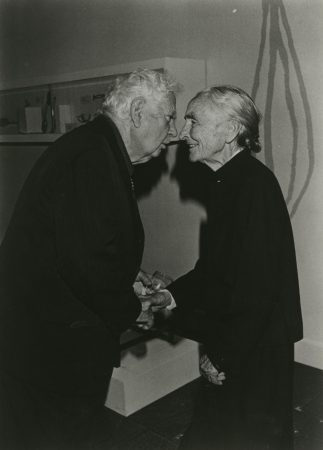
President Gerald Ford offers the Medal of Freedom to Calder. Calder replies, I was pleased to receive your invitation last week, but felt I could not accept in a case where my acceptance would imply my accord with the harsh treatment meted out to conscientious objectors and
deserters. As from the start I was against the war and now am working with “amnesty” I didn’t feel I could come to Washington. When there will be more justice for these men I will feel differingly [sic]. Ford posthumously awards Calder the Medal of Freedom. Louisa Calder declines to attend the ceremony: Freedom should lead to amnesty after all these years and it doesn’t seem as though it were going to happen. Freedom means freedom for all.
Calder returns with Louisa to New York from Washington, D.C., where he has finalized the details for Mountains and Clouds, a monumental stabile and mobile for the Hart Senate Building, Washington, D.C.
CF, object fileCalder dies in New York City at the home of his daughter Mary.
New York Times, 12 NovemberGalerie Maeght, Paris, exhibits “Calder: Mobiles and Stabiles.” The catalogue includes the essay “L’art et la comédie” by Jean Frémon and “Forme Humaine” by Jean Davidson, with cover and illustrations by Calder.
CF, exhibition fileThe Whitney Museum of American Art holds a memorial service. Officiating is director Tom Armstrong, with remarks by Sweeney, Saul Steinberg, cartoonist Robert Osborn, and Arthur Miller, and with a solo violin performance by Alexander Schneider.
CF, event file

